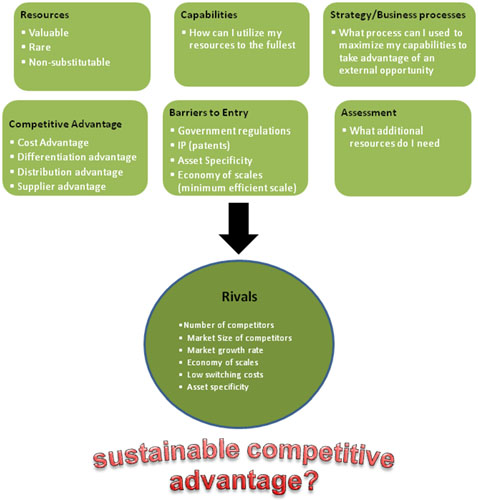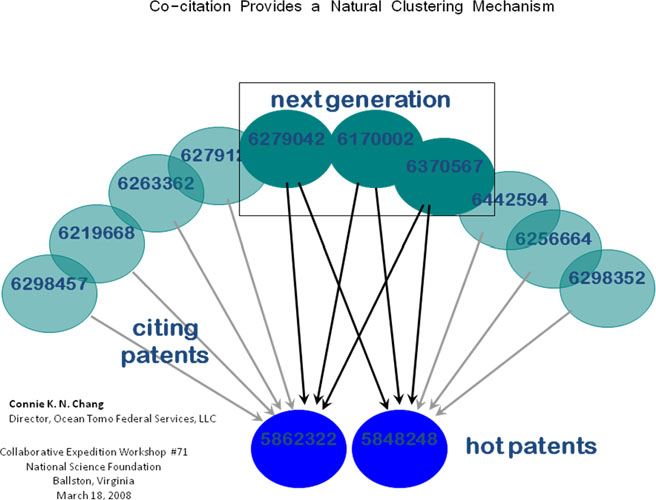This is a student paper from the 2010 final projects in the NIH Foundation for Advanced Education in the Sciences’ TECH 366 — Biotechnology Management. The students were asked to tell a story based on the course lectures, and to expand with general lessons on biotechnology company management.
Patent Analysis: A Tool for Making Strategic Business Decisions
Eric Norman
It takes 10-15 years and over a billion dollars to develop a drug and get it to market. Once in the market, only 2 out 10 drugs generate revenues that match or exceed its research and development costs[1]. Of the drugs reaching the commercial market less than a third become blockbusters, drugs that earn or exceed a billion dollars in revenues. These are the numbers for the success stories; in the pharmaceutical industry 1 out of 10,000 chemical compounds discovered are found beneficial and safe for commercialization[2]. In the face of these numbers, can a company truly grow big enough and diversify enough through mergers and acquisitions to ensure stability and future profits? I believe that a change is needed and that change is minimization, focus, and partnerships. This idea is not new for it has been made in a 2004 Businessweek article[3]. However, as with all big things, changing directions is slow and costly. In the eventual necessity of this change there will be a greater need for market analysis and strategic decision making for new drug development as a way of minimizing invested research and development dollars and subsequently, risk. Since innovation drives the market and innovation rests on intellectual property rights predominantly secured by patents, I believe that patent analysis can become the cornerstone for market analysis and strategic business decisions.
As a way of emphasizing patent analysis as a marketing and business strategy tool I have devised a flow chart comprising an integrative model of the resource base-view and Porter’s five forces, both of which are commonly used for assessing risk and potential value of new businesses and drug development. Although patent analysis does not address all issues that are encompassed by this business model, patent analysis serves as an economical approach to determine a focused marketing area, risk of new drug development, and potential value of a drug by addressing the following questions: What are my resources (IP)? How can I best use my IP? How does my innovation differ from that of my rivals? Who are my rivals? What are the potential markets? How crowded are these markets? Who are the innovators, leaders and laggards in these markets? Are there IP barriers to entry into this market? What is the likely direction of the market? What will it take to stay competitive in this market?

Patent analysis begins with a patentability and freedom to operate search. These two searches will provide relevant “prior art” that determines whether your innovation is patentable and has no IP impedance to commercialization. Next, based on the prior art a series of relevant patents can be collected and Patent Citation analysis can be done. Ocean Tomo, the leading Intellectual Capital Merchant Bank, has been innovators in patent analysis since 2003 and has devised various unique ways of using Patent Citation analysis[4,5]. In particular, Ocean Tomo has used Patent citation analysis as a way of determining the relatedness of patents for assessing potential litigation issues. However, modifications of this analysis can bring forth a list of potential markets that your innovation may have a use and potential partners to build collaborations to exploit those markets. In essence, through exploring the relationship between your patent and other patents there is a potential to generate additional revenues and/or diversification through: licensing part of your technologies to non-competitors, setting-up research partnerships to exploit an open market, or in-licensing a particular technology that would allow you to expand your market base or create additional IP barriers to prevent others from entering into the market. An additional use of Patent citation analysis, also utilized by Ocean Tomo, is to create categories of ‘hot topics’ and ‘next generation’ patents (figure 2). Hot topic patents are generally older patents that have a large number of citations by patents that expand a variety of technologies. They tend to be patents that lead to industry standards, disruptive technologies, and/or made a substantial impact across various industries. The ‘next generation’ of patents cites two or more of these ‘hot topic’ patents. The ‘next generation’ patents should represent patents that are improving and innovating upon an industry standard, suggesting that market adoption should be quicker with these technologies as oppose to the actual disruptive technology. Secondly, this analysis provides insight into potential market direction and who the innovators are for a particular technology group. These analyses should be substantiated through Patent Count Analysis[5]. Patent count analysis adds up the number of published (public) patents pending, issued, and abandoned for a technology group to assess the market drive/pull in a given industry; The greater the number of patents being filed and maintained in a particular industry the greater the probability that there is a profitable and growing market to support the investments being made in those intellectual properties. Furthermore, subdividing patent counts by ownerships gives an idea of the market leaders and how aggressively they are in using patents to prevent others from entering into the market. Pending on the analysis, the best business strategy may be to license your technology to the more aggressive company or seek a partnership with one of the rival companies that have approximately equal market size. Opposite to this, a large number of abandoned patents suggest that there is not enough money being made in the industry to justify continuing with the patent process and incurring additional fees or paying patent maintenance fees. Under these circumstances it may be better to forgo the patenting of the technology and either license the technology cheaper than it would cost to replicate the technology or make the technology available to everyone as ‘good will’ expense.

A final benefit of patent analysis is the valuation of your intangible properties for merger and acquisition, litigation, and/or taxes. The analyses discussed above can also be used to address three issues that underlie the valuation of intellectual properties: potential litigation issues, potential value of the technology (substitutable, ‘next generation’ technology, hot market area, and potential to be implemented in multiple markets), and the potential value of the market (market competitors, competitor market size, and a growing market). By addressing these issues you can have a clear idea of risk involved in the drug development and/or business development and can better utilized a more appropriate discount rate for calculated values determined by traditional market-base, asset-base, or income-base approach for valuation. In summary, product value is influenced by its scarcity and alternative uses. Patent analysis reflects scarcity and alternative uses of a product by outlining market availability, market need, market size, and market competitors.
In conclusion, through regular use of patent analysis you will be able to bring your drug development, IP portfolio management, business strategy, and business development groups together, using an integrative approach to minimizing research and development spending through targeted research projects and/or partnerships. As a single group, they can collectively use patent analysis to better position the company for the future through innovation and innovative strategies.
References
1. (Pharmaceutical Research and Manufacturers of America, Pharmaceutical Industry Profile 2010 (Washington, DC: PhRMA, March 2010)
2. (Davidson, L and Greblov G. The Pharmaceutical industry in the Global Economy (2005) Indiana University Kelley School of Business )
3. Arnst C, Barrett A, and Arndt M (2004) The Waning of The Blockbuster Drug. BussinessWeek Oct. 18 (http://www.businessweek.com/magazine/content/04_42/b3904034_mz011.htm)
4. Malackowski J.E., Barney J.A., Cardoza K, Walker M.D., and Gray C., (2006) Innovation Measurement: The Economic Impact of Patent Value: Business Submission at Ocean Tomo, LLC and Ocean Tomo Federal Services, LLC. Contact [email protected] or 312-327-4400.
5. Malackowski J.E. and Barney J (2009) Patent Attributions To Equity Returns. Business Submission at Ocean Tomo, LLC and Ocean Tomo Federal Services, LLC. Contact [email protected] or 312-327-4400.
6. Pohl M (2002) Patent Landscaping Studies: Their Use in Strategic Research Planning. Pharmaceutical Patent Attorneys, Pohl & Assoc. LLC. Contact: [email protected]
7. Grant RM (1991) The Resource-based theory of competitive advantage. California Management Review 33:114-135
About the author
Eric Norman received his Ph.D. in neuroscience from the University of Pittsburgh. Eric has spent many years conducting scientific research and has gained a broad knowledge of neurophysiology that culminated in a series of scientific articles. Currently working at NIH’s Office of Technology Transfer (OTT), Eric brings his scientific knowledge and critical thinking skills to the development of marketing campaigns aimed at promoting early stage technologies available at NIH and FDA. As a strong interest and personal passion, Eric studies the use of patent analysis and how it may be used in business development.